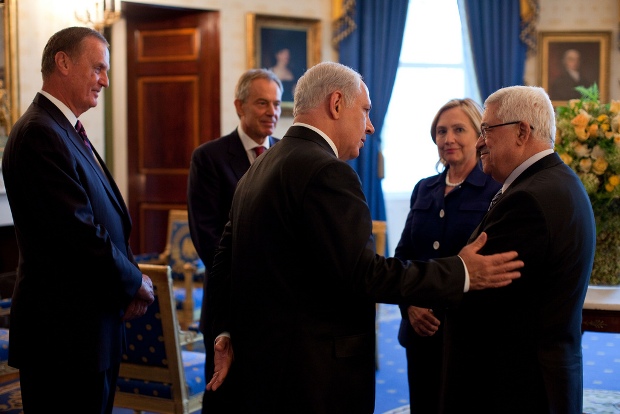The question is no longer about whether one state should be considered, as there is only one state which governs over two people. The question is which kind of state it will be: the left or the right-wing version.

The protests a few weeks ago in the West Bank against Palestinian Prime Minister Salam Fayyad, once the hope for an institutional and economic state-builder for Palestine, look like one more sign of failure for the emergence of a de facto if not de jure Palestinian state.
In the lead-up to September 2011, the Palestinian state appeared poised to advance towards greater general legitimacy.
Internationally, the political zeitgeist was there. The UN has long acknowledged the Palestinians’ right to self-determination, and Palestine has more formal recognitions of its independence (declared by the PLO in 1988) than any other un- or under-recognized entity. Like in Kosovo, protracted bilateral negotiations have failed, and unilateral statehood seemed to be the only remaining, if second-best, answer.
And if formal UN support fell short, I believed that even Israel’s hard-line, nationalist leaders would increasingly accept that a Palestinian state was in their rational interest – to avoid annexation and integration of millions of Palestinian citizens. Every leader since Rabin, including Prime Minister Netanyahu, has publicly acknowledged the preference for two states. While denying statehood officially and rhetorically, I believed Israel would quietly cultivate a reality of two separate states – economically, bureaucratically, through increased de facto Palestinian control and by boosting the PA.
The PA would then have been motivated to show democratic reforms, redress corruption and generally demonstrate state-worthiness, like some of the other state-hopeful cases.
Instead, the opposite has happened. Over the last year, Israel has wielded military, political and legal power to continue its land grabs in the West Bank. It has entrenched the legal and physical infrastructure of control over area C, ensuring separation of the Israeli and Palestinian populations, and discrimination against latter, who live under military government. Even PA control in area A remains circumscribed by Israeli military law.
These actions have increasingly undermined the PA. In July 2011, Palestinian pollster Khalil Shikaki told me that for Palestinian people, the UN bid was the PA’s last chance. Indeed, one year later, that leadership is insecure and faltering, governing only part of the Palestinian areas, and has hardly made new efforts at democratization. Elections are heard of, but not seen. Anger at corruption and economic hardship sparked the rioting, threatening the PA’s relevance altogether.
At present, one sovereign alone actually holds power over the territory from the river to the sea: Israel.
The two populations living under Israeli sovereignty (whether civilian or military sovereignty) have unequal rights, unequal resources, unequal opportunities and unequal realities.
Unable to ignore this situation, many Israeli analysts and political figures, including committed “two-staters,” have increasingly called to acknowledge a one-state reality. They come from both the far and middle left and the right, including Avraham Burg, and Speaker of the Knesset and Likud stalwart Reuven Rivlin. As a very broad characterization, the right-leaning version will curtail Palestinian rights or representation somewhere so that even if Palestinians become a majority, the Jewish state remains and Palestinians will be second class on some level; the left-leaning version will strive for full and equal rights, including political representation and probably in national character and symbols too. Symbolic and political representation, and demographics, is why many (not just right-wingers) worry about the “end of the Jewish state.”
To put it bluntly: the question is no longer about whether one state should be considered, because if we’re counting “states” who control people, it is already a reality. The question is which kind of state it will be: the left or the right wing version.

Remarkably, many American policy figures, Jewish leaders and intellectuals refuse to enter the debate. They keep talking about the negotiated two-state solution, which is becoming more slogan than substance, as if anyone on either side is listening.
That’s unfortunate. A moratorium on thinking about it will not change the facts. The vain attempts to stifle criticism of Israel in American Jewish discourse and in American politics proved that uncomfortable realities can’t be wished away.
It would also be foolish to pretend I don’t understand the desire to erase the topic. Most Jews view one state as the catastrophic destruction of the Jewish state. They are scared – I was too. I have been a “committed two-stater” ever since college, when I was old enough to think about it, long before I moved to Israel. Two states wasn’t very popular then, and positioned me on the political margins. In that sense, it’s not only part of my political identity – two-states has been part of my personal identity. But paradigms shift and we must be brave enough to sacrifice our familiar individual identities to adapt to historic realities. Keeping the question in the dark deepens the mystique and heightens the fear of the unknown.
The best response is to start demystifying that unknown. It’s time to dive in and start confronting what one state really means. This will help us cut through the emotional noise, analyze problems and advance realistic proposals (“solutions” at this stage would be a stretch). If there are no workable answers, we must acknowledge that too and maybe that will lay the whole theme to rest.
This is not just an acceptable discussion. It is an urgent one. The far right is implementing its own vision at present. Soon we’ll be reading articles calling to acknowledge an undeniable reality of apartheid. An alternate political vision must emerge that can theoretically interest the wide majority of Israelis who are not of the far right. That vision must involve both true equality, and acknowledge national, collective rights for two communities.
I can’t do all that here. Instead, I’ve started by listing what I view as the toughest, most painful issues head-on, because we’ve learned our lesson about leaving core issues for the end. I’ve opened up broad directions for addressing them. Then the real work begins.
1. Ongoing occupation. Under a single state, what is to stop Israel from continuing to encroach on Palestinian land rights, discriminating in resources, infrastructure, and law, restricting a wide range of human and civil rights, crushing economic potential of Palestinian-populated areas, and keeping the people of Gaza in prison? Proposal: Freeze the maps. In return for not being asked to dismantle the entire settlement project, Israel agrees to establish no new settlements at all. Zero tolerance, genuine enforcement: no winking and legislating around it – dismantle those hilltop caravan clusters too. Allowing individuals to live freely anywhere will be the logical next step; outside cities, it’s likely most people will naturally gravitate to their own communities anyway.
2. National narratives. It was too early to eulogize nationalism in the 1990s and it is too early now. Identity matters, and the symbols that stand for them matter too; people kill over these things. Will there be two sets of symbols? Symbols that incorporate both people? Civic symbols and separate national symbols – three different sets? Proposal: Each community keeps its symbols; the country appears internationally as a federated state with its two nations forming its identity. Although awkward, it may be better to use both flags, than deny anyone’s existence. And both sides stop the post-modern game of pretending they can educate the other out of existence.
3. Political/electoral system: Israel votes with a single-constituency proportional representation and coalition system. Should an electoral or governing system guarantee a grand coalition, minority or community veto rights, require a majority in both communities for major decisions, or any other constitutional guarantees of divided societies? It’s worth remembering that these often don’t work; constitutions have failed to prevent implosions of Cyprus, Yugoslavia, and Somalia and other places. Proposal: Some constitutional or electoral guarantees of bi-communal representation in executive power; but these should be kept to a minimum to avoid ongoing accusations of breaches.
4. No catharsis. The Palestinian and Israeli people, international leaders, a whole fleet of diplomats, countless civil society groups, tireless activists, all of which have cost a sea of money – the people living in exile, under occupation or under rocket fire – will be forced to accept a whimper but no bang: no handshakes on the White House lawn, no soaring speeches. My only proposal is to remind ourselves that we the people of Israel and Palestine voted in the leaders who brought this situation about; if we had wanted it otherwise, we would have had to act differently.
5. Palestinian refugees. No creative solution will make this problem easier. Proposal: go back to the Saudi/Arab Peace Initiative – and allow for some number to return, pending the agreement of both sides.
Others can probably add to this list of thorniest things.
I can’t say this is what I personally hoped for all these years. Nor can I say that this is what will be – maybe we’ll all be surprised when the next American administration pulls a two-state rabbit out of its hat. But holding our breath for a negotiated two state solution is liable to cut off the oxygen to this land.

